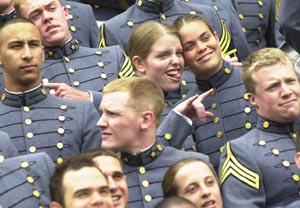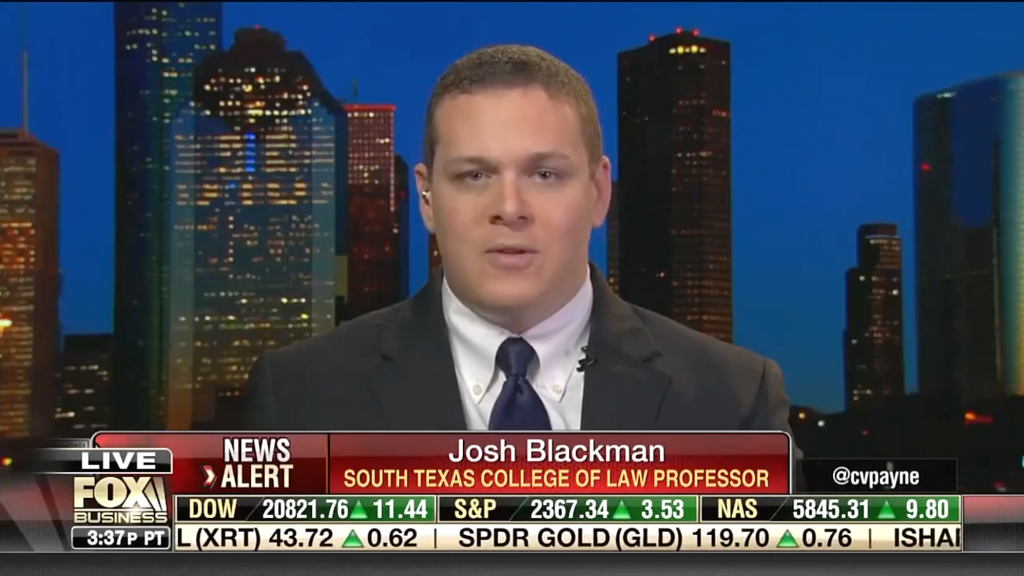On March 6, 2017, President Trump issued a new executive order on immigration that superseded an order he signed on January 27. For an in-depth discussion on the first order, please see my two-part series on Lawfare ((Part I and Part II) ) and my forthcoming essay in the Texas Law Review See Also, titled The 9th Circuit’s Contrived Comedy of Errors in Washington v. Trump.
I will analyze the new executive order in three parts. In Part I, I addressed how the new order comported with the Immigration and Nationality Act. In Part II, I assessed how the new order comports with the Fifth Amendment’s Due Process clause. This final part will analyze how the new order fares under the Establishment Clause.
The Establishment Clause and Immigration Law
Two decades ago, immigration scholar Enid F. Trucios-Haynes observed in the Georgetown Immigration Law Journal that applying the Supreme Court’s Establishment Clause jurisprudence to long-standing immigration laws “is particularly awkward.” Under either the Lemon test or the related “endorsement” test, a facially neutral law with a non-secular purpose is constitutionally suspect. A law that prefers religion over non-religion is very likely unconstitutional. A law that overtly prefers certain religious sects over others is almost certainly unconstitutional. Yet, immigration law routinely does all of the above, and neither Congress nor the courts have expressed even the slightest concern for the Establishment Clause—that is, until President Trump’s executive order.
A fitting starting point is a case many lawyers are familiar with: Rector, Etc. of Holy Trinity Church v. United States. Justice Brewer’s 1892 decision is still studied for the “familiar rule that a thing may be within the letter of the statute and yet not within the statute, because not within its spirit nor within the intention of its makers.” But the facts that gave rise to the case are far more relevant to our discussion than this canon of construction.
Congress had enacted a statute that prohibited any corporation from assisting immigrants in entering the United States to perform labor. Despite the plain text, the Holy Trinity Court concluded that that Congress did not have in mind “any purpose of staying the coming into this country of ministers of the gospel, or, indeed, of any class whose toil is that of the brain,” because “preaching” is not “labor,” as the term was commonly understood. Indeed, as a general matter, the Court found that “no purpose of action against religion can be imputed to any legislation, state or national, because this is a religious people.” The opinion cites the godly nature of Columbus’s voyage, the first charter of Virginia, the Mayflower Compact, and the Declaration of Independence. One would think that such a construction would raise Establishment Clause concerns, and that the statute should be read to avoid that outcome; indeed, when the plain text compels that result, the Court’s decision becomes even less justifiable. But such concerns were nonexistent, as the Establishment Clause lacked any teeth in 1892.
By all accounts, however, Justice Brewer had in fact ascertained Congress’s intent. Since 1952, when Congress codified the Immigration and Nationality Act, our law has afforded a “special immigrant” status to aliens that seek to enter the United States “solely for the purpose of carrying on the vocation of a minister of that religious denomination.” Here, Congress bestows a benefit exclusively based on the fact that the alien is a minister. Atheists need not apply. For those who check such things—and it is relevant under Lemon—one scholar observed that the “legislative history of the 1952 amendment to the Federal Immigration Act is replete with references to religious purpose and motivation,” referencing the role religion plays in “shaping American culture.” The purpose, and effect of this provision is unmistakable: advancing religion.
Countless BIA decisions have construed this provision; none raise even the slightest Establishment Clause doubts. For example, In the Matter of Balbin involved excessive entanglement, as the court had to determine whether, under an earlier version of the statute, the church in fact needed the minister’s services. Such a regime would be verboten under traditional Equal Protection caselaw.
Were the constitutional doubts of the 1952 statute not strong enough, the implementing regulations that define “vocation” are even less neutral:
Religious vocation means a formal lifetime commitment, through vows, investitures, ceremonies, or similar indicia, to a religious way of life. The religious denomination must have a class of individuals whose lives are dedicated to religious practices and functions, as distinguished from the secular members of the religion. Examples of vocations include nuns, monks, and religious brothers and sisters.
This regulation is clearly framed to mirror religious structures similar to that of the Roman Catholic church, where officials take a “lifetime commitment,” and not based on other faiths where spiritual leaders may have different, less-permanent approaches to devotion. More importantly, Professor Trucios-Haynes observed, “Nontraditional religions, that are not similarly organized in comparison to religions containing nuns, monks, religious brothers, and sisters, must explain their religious doctrine.” As a result, she noted, “[t]hese organizations are subject to a far more searching inquiry by bureaucratic decisionmakers.” For other faiths, devotion need not be a lifelong commitment, in the same sense as monks or nuns. Thus, they are disadvantaged under our immigration laws. Indeed, Professor Trucios-Haynes’s study of the legislative history reveals a preference “to permit entry of members of certain religious denominations, i.e., Roman Catholic members, but to limit the entry of members of other religious denominations.” In any other context, were Congress to so nakedly prefer religion over non-religion, and Catholics over non-Catholics, the law would have already been enjoined. Yet, these provisions have remained in effect for over half a century, without raising any judicial doubts. (Indeed, recent decisions considering the regulation’s legality on other grounds did not even mention the Establishment Clause).
Though the vocation statute favors religious aliens over non-religious aliens, it is facially non-denominational. That is, on its face, the law does not prefer Catholic priests over Jewish rabbis. The same cannot be said for the so-called “Lautenberg Amendment.” During the late 1980s, as more Jews were permitted to emigrate from the Soviet Union, there was a movement afoot in the Reagan Administration to “rethink[] the almost automatic granting of refugee status” to these aliens. In 1989, Sen. Frank Lautenberg (D-NJ) and Rep. Bruce Morrison (D-CT) introduced a legislative response, that would become known as the Lautenberg Amendment. Section 599D of the Foreign Operations, Export Financing, and Related Programs Appropriations Act stated that “Aliens who are (or were) nationals and residents of the Soviet Union and who are Jews or Evangelical Christians shall be deemed” to be subject to persecution, unless there was sufficient evidence to the contrary. In other words, the law established that by virtue of a Soviet’s faith—Judaism or Evangelical Christianity—courts should presume the alien’s claim of persecution. In such cases, the burden is on the government to establish that no such persecution is present. This reverses the usual framework. Several members of Congress opposed the bill because it granted preferential treatment to Soviet Jews; but none objected that favoring Soviet Jews and Evangelicals would run afoul of the Establishment Clause. Ultimately, the Amendment passed 97-0 in the Senate, and 358-44 in the House.
As a general matter, many core aspects of refugee law raise Establishment Clause problems. For example, determinations of whether an alien faces a “well-founded fear of prosecution” based on religion unnecessarily entangles the government in deciding the contours of spiritual doctrines. The Lautenberg amendment, however, does not merely prefer claims of religious-aliens over non-religious aliens, but instead grants preferential treatment to two specific sects within the Soviet Union: Jews and Evangelicals. There is no mistaking the purpose of the law. And its effect was patent. As a result of the Amendment, the rate of applicants interviewed in Moscow that were approved for refugee status increased from 78% to 90%, raising the prospects of Jews and Evangelicals to seek refugee status. This policy is facially invalid under the Lemon test. Yet, I could not locate even the slightest suggestion that the Lautenberg Amendment was unconstitutional.
My tentative conclusion is the Establishment Clause, in light of foreign policy concerns and Congress’s plenary powers over naturalization, simply has not applied with full force to immigration law. This observation is buttressed by the now-familiar 8 U.S.C. § 1152(a)(1)(A). Enacted as part of the landmark 1965 Immigration and Nationality Act, this provision was designed to root out discriminatory quotas in immigration policy. It provides:
Except as specifically provided in paragraph (2) and in sections 1101(a)(27), 1151(b)(2)(A)(i), and 1153 of this title, no person shall receive any preference or priority or be discriminated against in the issuance of an immigrant visa because of the person’s race, sex, nationality, place of birth, or place of residence.
If you read it quickly, you may gloss over the fact that there is a critical element missing: religion. That choice was deliberate. It is perfectly permissible under the statute to discriminate on the basis of religion when deciding whether to issue immigrant visas. (Non-immigrant visas can be restricted based on nationality, or any other basis for that matter).
I reiterate that this conclusion is tentative. No court has ever confronted this question. This uninterrupted, uncontroverted practice should at least give courts pause before extending Lemon to this context over which Congress has plenary power, and the President has heightened concerns over foreign affairs. Washington v. Trump and Aziz v. Trump simply assumed the Establishment Clause applied with full force to the executive order.
It is not surprising that such Establishment Clause challenges have not arisen. Imagine a Buddhist living in the Soviet Union in 1990 challenged the Lautenberg Amendment as an unconstitutional establishment, which deprived him of the opportunity to receive one of the statutorily-limited number of refugee slots. Such a suit would have been tossed out of court. But, at bottom, this is the gravamen of the latest round of litigation in Washington v. Trump.
If my tentative conclusion is correct, then I would be very hesitant to apply the Lemon or endorsement test to the executive order, as it would put in doubt countless provisions of the INA that grants preferential treatment for religious aliens, and at that, aliens of certain religious sects. Granted, I am not a fan of Lemon, as I noted in one of my first published articles. I would far prefer a test premised on coercion, rather than endorsement. In that case, the executive order would be unassailable. I will assume in the remainder of the post that the Lemon test applies to immigration law.
The Sole Organ
McCreary County v. ACLU applied a purposivist approach to the Establishment Clause and instructs lower courts to look behind a facially neutral policy to ascertain religious pretext. In that case, the Court studied the legislative history of a series of Ten Commandments displays to find a preference for promoting Christianity. In other cases, the court has looked even further for improper motive, focusing on statements that were extraneous to the policy, or even less-reliable, post-enactment legislative history.
In Epperson v. Arkansas, the Court cited an advertisement placed in a newspaper in support of the law forbidding the teaching of evolution in public schools. In Stone v. Graham, the Court invalidated a Kentucky law that required posting of the Ten Commandments in public schools. The Court offered no explanation as to why there was a forbidden purpose, stating perfunctorily, “the pre-eminent purpose for posting the Ten Commandments on schoolroom walls is plainly religious in nature.” The Court pronounced that “no legislative recitation of a supposed secular purpose can blind [them] to the fact” that the Ten Commandments are a religious symbol. (The Court’s later decision in Van Orden v. Perry is much to the contrary).
In Santa Fe Independent School District v. Doe, the Supreme Court held that a student-led, student-initiated prayer before high school football games violated the First Amendment and rejected the government’s proffered secular purpose. Here too, the Court cited post-enactment legislative history. In Wallace v. Jaffree, the Court struck down a law requiring a moment of silence in public schools, concluding that it lacked a clearly secular purpose. Unlike Epperson and Stone, where the Court did not even attempt to analyze legislative history, Justice Stevens devoted several pages of Jaffree to examining a detailed history of the enactment of the statute. Alas, much of it was post-enactment legislative history from a single member.
This fly-by-the-seat-of-your-pants approach to constitutional law has long troubled me, and led me to write “This Lemon Comes as a Lemon. The Lemon Test and the Pursuit of a Statute’s Secular Purpose” for a 3L seminar on the First Amendment. It was later published by the George Mason Civil Rights Law Journal. My primary critique of the doctrine focused on the fact that trying to discern the intent of a collective body—especially by referring to post-enactment legislative history—was a ruse. As Kenneth Shepsle famously put it, “Congress is a they, not an it.”
A different framework, however, applies when discerning the purpose of the unitary executive. Indeed, this is the basis of the off-cited but seldom analyzed dictum from United States v. Curtiss-Wright. When the President speaks, he speaks with one voice as the “sole organ” of the executive branch. (This principle is why he has the authority to supervise the social media accounts of his agencies).
Over the past few years, I’ve maintained that courts should consider the President’s statements to demonstrate whether he is faithfully executing the laws. Usually, courts listen to the “sole organ” speak through the form of general policy statements issued by an executive branch agency, or even developed by the Justice Department during the course of litigation. Seldom do we see such specific reflections from the Commander in Chief himself. To this end, I think it is possible to ascertain the President’s purpose, whether under the Take Care Clause or under the Court’s Establishment Clause jurisprudence. Congress is a they, but the President is a he. As a result, President Trump’s statements are certainly fair game for an Establishment Clause analysis.
The Old and New Orders
The President’s initial January 27, 2017 executive order made several overt references to religion. First, the order stated that “the United States should not admit those who engage in acts of bigotry or hatred (including ‘honor’ killings, other forms of violence against women, or the persecution of those who practice religions different from their own).” Though this statement does not reference any particular religion, the notion of “honor” killings is usually associated with Islam. Second, the order stated that the Secretary of States should “prioritize refugee claims made by individuals on the basis of religious-based persecution, provided that the religion of the individual is a minority religion in the individual’s country of nationality.” (Query for a moment how this provision is distinguishable from the Lautenberg Amendment, which expressly gave preferential treatment to refugee claims from Soviet Jews, because of their religious-minority status). Third, during the “temporary suspension,” the Secretary can still choose to admit an alien who “is a religious minority in his country of nationality facing religious persecution.” (Likewise, this provision is apiece with the Lautenberg Amendment.) Fourth, the order asked the Secretary of State to submit a report “regarding prioritization of claims made by individuals on the basis of religious-based persecution.” (A fifth possible ground concerning the selection of the seven predominantly-Muslim nations will be addressed later in this post).
The March 7, 2017 order removes the final three references to religion and prioritization for religious minorities, but it does request the collection of information about “so-called ‘honor killings.’” More directly, the new order repudiates the notion that the old order permitted discrimination on the basis of religion:
Executive Order 13769 did not provide a basis for discriminating for or against members of any particular religion. While that order allowed for prioritization of refugee claims from members of persecuted religious minority groups, that priority applied to refugees from every nation, including those in which Islam is a minority religion, and it applied to minority sects within a religion. That order was not motivated by animus toward any religion, but was instead intended to protect the ability of religious minorities — whoever they are and wherever they reside — to avail themselves of the USRAP in light of their particular challenges and circumstances.
Despite the fact that the new order is facially neutral and eliminates all references to religion, many commentators have continued to view it as the proverbial fruit from the poisonous tree. That is, changes to the four corners of the document cannot remove its “forever taint” of animus. Eric Posner, Michael Dorf, Ilya Somin, and many others have made this claim. This claim is worth investigating in light of a careful study of Justice Souter’s opinion in McCreary County v. ACLU.
McCreary County v. ACLU
The Court’s most relevant statement concerning the Establishment Clause was articulated in Justice Souter’s decision in McCreary County v. ACLU. In this case, the county posted three different displays of the Ten Commandments in its courthouse. The first version was a “gold-framed cop[y] of an abridged text of the King James version of the Ten Commandments, including a citation to the Book of Exodus.” The Judge-Executive posted the display at a ceremony, joined by a local pastor, and referred to the Decalogue as a “creed of ethics.” The ACLU sough a preliminary injunction. Before the court ruled on the motion, the County “authorized a second, expanded display, by nearly identical resolutions.” Many of the county’s resolutions expressly referenced religion. Display 2.0 included the edited King James version of the Ten Commandments, alongside eight other documents, including the Preamble to the Declaration of Independence, a proclamation from Abraham Lincoln, and the Mayflower Compact. (Each document made reference to God or the Bible). The District Court soon entered a preliminary injunction, finding that the display “lack[ed] any secular purpose” under the Lemon test.
The County initially filed a notice of appeal, but dismissed it after retaining new counsel. Then a third display was posted. Justice Souter noted that “[n]o new resolution authorized this one, nor did the Counties repeal the resolutions that preceded the second.” Display 3.0 consisted of “nine framed documents of equal size, one of them setting out the Ten Commandments explicitly identified as the ‘King James Version’ at Exodus 20:3–1.” The other documents in the mélange were the “Magna Carta, the Declaration of Independence, the Bill of Rights, the lyrics of the Star Spangled Banner, the Mayflower Compact, the National Motto, the Preamble to the Kentucky Constitution, and a picture of Lady Justice.” The ACLU sought to enjoin the third display. In court, counsel defended the latest iteration by focusing on the role that the Ten Commandments have played in our legal order. The district court, however found that display still had “a religious, rather than secular, purpose.”
On appeal, Justice Souter’s analysis focused almost exclusively on the Lemon test’s purpose prong, which asks whether the government action has “a secular legislative purpose.” The Court employed the so-called “objective observer” test to ascertain if a law has a valid secular purpose, or an improper sectarian purpose. This paragraph summarizes the rule well:
But scrutinizing purpose does make practical sense, as in Establishment Clause analysis, where an understanding of official objective emerges from readily discoverable fact, without any judicial psychoanalysis of a drafter’s heart of hearts. Wallace (O’Connor, J., concurring in judgment). The eyes that look to purpose belong to an “‘objective observer,’” one who takes account of the traditional external signs that show up in the “‘text, legislative history, and implementation of the statute,’” or comparable official act. Santa Fe (quoting Wallace) (O’Connor, J., concurring in judgment); see also Edwards v. Aguillard (enquiry looks to “plain meaning of the statute’s words, enlightened by their context and the contemporaneous legislative history [and] the historical context of the statute, … and the specific sequence of events leading to [its] passage”). There is, then, nothing hinting at an unpredictable or disingenuous exercise when a court enquires into purpose after a claim is raised under the Establishment Clause.
The Court debated with its own precedents about how predominant the religious purpose must be for the policy to cross the constitutional line. Ultimately, Justice Souter settled on a standard: “although a legislature’s stated reasons will generally get deference, the secular purpose required has to be genuine, not a sham, and not merely secondary to a religious objective.” For good measure, Justice Souter cited Justice O’Connor’s concurring opinion from Lynch v. Donnelly, in which “provided the fifth vote.” In the 1984 case, the Junior Justice wrote that “the purpose inquiry ‘is not satisfied . . . by the mere existence of some secular purpose, however dominated by religious purposes.’”
With that framework established, the majority considered the county’s defenses. First, the government asserted that “purpose in a case like this one should be inferred, if at all, only from the latest news about the last in a series of governmental actions, however close they may all be in time and subject.” In a now-famous line, Justice Souter countered, “But the world is not made brand new every morning, and the Counties are simply asking us to ignore perfectly probative evidence.” The objective observer must not be “absentminded,” the Court explained. Instead, he must be “presumed to be familiar with the history of the government’s actions and competent to learn what history has to show.” The opinion cited Justice O’Connor’s opinion in Wallace, which focused on the “implementation of” the government action.
With respect to the county’s first display, the Court observed that a “reasonable observer” of the posting ceremony—which included a pastor reaffirming the “existence of God”—“could only think that the Counties meant to emphasize and celebrate the Commandments’ religious message.” The Ten Commandments, with no other context, “did nothing more to counter the sectarian implication than the postings at issue in Stone.”
With respect to the county’s second display, the juxtaposition of “the Commandments to other documents with highlighted references to God as their sole common element” underscored “an indisputable, and undisputed, showing of an impermissible purpose.” The government defended the third display by connecting the Ten Commandments with the “historical foundation of American government.” However, the Court rejected these new “statements of purpose” as a mere “litigating position,” especially in light of the fact that the county did not adopt “a new resolution or repeal . . . the old one.” Notwithstanding this purpose, the Court still found the third display to have a “sectarian spirit,” as it “quoted more of the purely religious language of the Commandments than the first two displays had done.” With that, the Court ruled for the ACLU.
Aziz v. Trump
The Ninth Circuit panel in Washington v. Trump addressed the Establishment Clause argument but ultimately ruled on procedural due process grounds. The leading judicial opinion focusing on this former ground was offered by Judge Brinkema (EDVA) in Aziz v. Trump. The opinion is largely premised on McCreary. Indeed, this is an apt precedent for considering the legality of President Trump’s two orders. In both cases, the government went through several iterations of a policy in response to Establishment-Clause litigation. In both cases, the government evinced various sectarian purposes. And, in both cases, the government urged the court to ignore the purpose of the policy, and disclaiming old history as “dead and buried.” Before I delve into the analysis, however, I need to take a slight fact-checking detour.
On December 7, 2015, then-candidate Trump announced in a press release that he was calling for a “for a total and complete shutdown of Muslims entering the United States until our country’s representatives can figure out what is going on.” The next day, Governor Mike Pence of Indiana tweeted, “Calls to ban Muslims from entering the U.S. are offensive and unconstitutional.” Seven months later on 60 Minutes, host Lesley Stahl interviewed Trump and Pence, and asked the VP candidate about his tweet. Trump interrupted Stahl, and there was cross-talk:
LESLEY STAHL:– in December you tweeted, and I quote you, “Calls to ban Muslims from entering the U.S. are offensive and unconstitutional.”
DONALD TRUMP: So you call it territories. Okay? We’re going to do territories. We’re going to not let people come in from Syria that nobody knows who they are. Hillary Clinton wants 550 percent more people to come in than Obama —
LESLEY STAHL: So you —
DONALD TRUMP: — who doesn’t know what he’s —
LESLEY STAHL: — so you’re changing —
DONALD TRUMP: — so we’re going to —
LESLEY STAHL: — your position.
DONALD TRUMP: — no, I — call it whatever you want. We’ll call it territories, okay?
LESLEY STAHL: So not Muslims?
DONALD TRUMP: You know — the Constitution — there’s nothing like it. But it doesn’t necessarily give us the right to commit suicide, as a country, okay? And I’ll tell you this. Call it whatever you want, change territories, but there are territories and terror states and terror nations that we’re not going to allow the people to come into our country. And we’re going to have a thing called “Extreme vetting.” And if people want to come in, there’s going to be extreme vetting. We’re going to have extreme vetting. They’re going to come in and we’re going to know where they came from and who they are.
For those who have only listened to Donald Trump, and never read his transcribed remarks, the above passage must be frustrating. Trying to figure out exactly what the Donald was saying is maddening. Yet, Judge Brinkema—with the aplomb of a fact-checker—tells us precisely what was on his mind:
The president connected that policy to this EO when, asked last July if he had abandoned his plan for a Muslim ban, he responded “Call it whatever you want. We’ll call it territories, OK?”
You follow? The court suggested that Trump’s response to Stahl indicated that his Muslim-ban was no different than his later-territory ban. Judge Brinkema fails to include Trump’s remarks from “Meet the Press” the following week where he clarified what he meant by “territories.”
CHUCK TODD: The Muslim ban. I think you’ve pulled back from it, but you tell me.
DONALD TRUMP: We must immediately suspend immigration from any nation that has been compromised by terrorism until such time as proven vetting mechanisms have been put in place.
CHUCK TODD: This feels like a slight rollback–
DONALD TRUMP: I don’t think that’s–
CHUCK TODD: Should it be interpreted–
DONALD TRUMP: I don’t think so. I actually don’t think it’s a rollback. In fact, you could say it’s an expansion. I’m looking now at territories. People were so upset when I used the word Muslim. Oh, you can’t use the word Muslim. Remember this. And I’m okay with that, because I’m talking territory instead of Muslim.
“I’m talking territory instead of Muslim.” That is, Trump established that his policy would affect certain countries, rather than a specific religion. Which one is it? Is Trump keeping the Muslim ban or abandoning it? Perhaps Trump was lying on “Meet the Press”? Perhaps he was confused on “60 Minutes”? Maybe he had a “lousy earpiece”? The fact that an Article III inquiry comes down to whether we give more weight to interviews from Chuck Todd or Lesley Stahl suggests how fraught Judge Brinkema’s analysis is.
Later in her opinion, Judge Brinkema acknowledges, “As the campaign proceeded, there were fewer references to an outright ban on Muslim immigration, with the focus switched to a ban on persons from territories that have a Muslim majority.” Wouldn’t it also be fairer to say that the President overtly abandoned the “Muslim Ban” policy, and instead focused on several nations which pose specific risks? Courts should not be in the business of parsing ambiguous and garbled statements of a notoriously-incoherent politician. Justice Scalia’s dissent in McCreary warned against “making the passing comments of every government official the subject of endless litigation.” He was right.
Our fact-checking inquiry next takes us to former-Mayor Rudolph Giuliani. On Sunday, January 29, 2017, he was interviewed on the Fox News Channel about the two-day-old executive order. The Aziz court offered this excerpt:
‘I’ll tell you the whole history of it[.]’… ‘So when [Trump] first announced it, he said ‘Muslim ban.’ He called me up. He said, ‘Put a commission together. Show me the right way to do it legally.’… ‘And what we did was, we focused on, instead of religion, danger—the areas of the world that create danger for us[.]’… ‘Which is a factual basis, not a religious basis. Perfectly legal, perfectly sensible. And that’s what the ban is based on. It’s not based on religion. It’s based on places where there are [sic] substantial evidence that people are sending terrorists into our country.’
From this, Judge Brinkema concludes that “Giuliani said two days after the EO was signed that Trump’s desire for a Muslim ban was the impetus for this policy.” The use of the phrase “impetus” here is unclear. Giuliani’s remarks establish that a “Muslim Ban” was not lawful, but it was lawful to deny entry to aliens from “areas of the world that create danger for us.” The policy was “not based on religion.” To use Trump’s parlance, these are the dangerous “territories.”
Judge Brinkema’s ellipses also omitted who worked on the policy. Giuliani said, “I put a commission together with Judge [and former Attorney General] Mukasey, with Congressman [and Chairman of the Homeland Security Committee] McCaul, [Representative and former Chair of the Homeland Security Committee] Pete King, whole group of other very expert lawyers on this. Judge Brinkema discounts these experts’ opinion, because “there is no evidence that this commission was privy to any national security information when developing the policy.” (How could she possibly say that about the Chair of the Homeland Security Committee?!). But in any event, this inquiry moves the goal posts. If she thought Giuliani was in fact enabling a secret-Muslim ban, then that would be true, too, of former-Attorney General Mukasey. The court’s uncharitable reading of both Trump and Giuliani is better served for a Sunday morning talk show, not a federal court.
One other statement is worth a brief mention. On January 27, 2017, President Trump was interviewed on the Christian Broadcasting Network. Host David Brody asked if “persecuted Christians” should be a priority in the refugee program. Trump answered, “Yes.” He continued, “If you were a Muslim you could come in, but if you were a Christian, it was almost impossible.” This is precisely the sentiment expressed by the Lautenberg Amendment—that minority religions that are persecuted should be a priority. Indeed, ultimately the executive order did not apply only to Christians, but to all minority-religions. On its face, in a majority Christian nation, persecuted Muslims would have received a priority. In any event, this provision was stripped from the March executive order.
Forever Taint
The crux of Judge Brinkema’s legal analysis can be crystalized in a single sentence from her opinion: “In other words, what matters is what an “objective observer” would draw from the text of the policy, enlightened by historical context and ‘the specific sequence of events leading to’ its adoption.” One would think that her analysis would indeed begin with the “specific sequence of events leading to’ [the] adoption” of the executive order. Not quite.
At its heart, the court’s Establishment Clause analysis isn’t about the executive order. Rather, it is about the person who signed it. In a section titled “The President’s Public Comments,” the court lists several statements made by Donald Trump “on the subject of immigration to the United States by Muslims.” Consider the level of generality. These were not statements concerning the executive order itself, or even statements about the executive order ultimately adopted. They are statements about Donald Trump’s personal views on “the subject of immigration to the United States by Muslims.”
Judge Brinkema begins her analysis, chronologically, with Donald Trump’s appearance on the O’Reilly Factor in 2011. During a segment about the construction of a mosque near the World Trade Center—the so-called Ground Zero mosque—the host asks the reality-TV star, is “there is a Muslim problem in the world?” Trump replied, “Absolutely. Absolutely. I don’t notice Swedish people knocking down the World Trade Center.” He continues to talk about the decision to build a mosque near the World Trade Center, which was “very insensitive.” The host asks again, if he “believe[s] overall there is a Muslim problem in the world.” Trump answers, “Well, there is a Muslim problem. Absolutely. You just have to turn on your television set.” O’Reilly counters, “And do you think it encompasses all Muslims?” Trump then offers an explanation that was omitted from Aziz:
No. And that’s the sad part about life. Because you have fabulous Muslims. I know many Muslims and they’re fabulous people. They’re smart. They’re industrious. They’re great. Unfortunately, at this moment in time, there is a Muslim problem in the world. And by the way, and you know it and it I know it and some people don’t like saying it because they think it’s not politically correct.
This segment had nothing to do with immigration. Judge Brinkema used ellipses to elide the discussion of the Ground Zero mosque, and create the impression Trump was talking about immigration.
Next, the court jumped ahead nearly five years to December 2015 when then-candidate Trump called for a “for a total and complete shutdown of Muslims entering the United States until our country’s representatives can figure out what is going on.” What was the connection between the two incidents? The “shutdown,” she wrote, was “consistent with views that the president has expressed on various occasions over the last six years.” Again, the O’Reilly Factor segment had nothing to do with immigration policy. Judge Brinkema’s not-too-subtle point—by way of the word “consistent”—is that Donald Trump is an anti-Muslim bigot. I would have much preferred that simply acknowledged her sentiment, rather than couching it in judicial garb, but this was precisely her conclusion. Why else mention the O’Reilly Factor segment which predated the executive order by nearly six years?
There is absolutely no support for this sort of judicial reasoning. Tarring Trump with the brush of bigotry by citing statements that were utterly unconnected with the executive order at issue is precisely what Justice O’Connor advised against in Wallace v. Jaffree: a “judicial psychoanalysis of a drafter’s heart of hearts.” There is a paragraph in McCreary that logically Judge Brinkema should have cited—as it supports her reasoning—but inexplicably she did not:
In holding the preliminary injunction adequately supported by evidence that the Counties’ purpose had not changed at the third stage, we do not decide that the Counties’ past actions forever taint any effort on their part to deal with the subject matter. We hold only that purpose needs to be taken seriously under the Establishment Clause and needs to be understood in light of context; an implausible claim that governmental purpose has changed should not carry the day in a court of law any more than in a head with common sense. (emphasis added).
Judge Brinkema has applied a “forever taint” not to the executive order, but to Donald Trump himself. For example, the government defended the selection of the seven nations in the initial executive order because President Obama approved a law that singled out the same seven nations for “special scrutiny” under the visa waiver program. Judge Brinkema rejected this reasoning: “Absent the direct evidence of animus presented by the Commonwealth, singling out these countries for additional scrutiny might not raise Establishment Clause concerns; however, with that direct evidence, a different picture emerges.” That is, if Barack Obama selected these seven countries for extreme vetting, it would be lawful, because he lacks the animus. But because Donald Trump had that animus, it would be unlawful. No matter that Trump excluded forty-three other Muslim-majority nations that account for 90 percent of the global Muslim population. Even though three of the included nations are state-sponsors terrorism! It will always a “Muslim ban” because of comments he made on the O’Reilly Factor in 2011, a policy he adopted in 2015, and abandoned after his lawyers told him it was illegal. She admits as much. “A person,” she writes, “is not made brand new simply by taking the oath of office.” Not the policy. The person. Trump.
Discounting punditry from Rudy Giuliani, and a typically-garbled statement from Trump, the court premised its opinion on the supposed fact that Trump is an anti-Muslim bigot. This conclusion will infect every Establishment Clause challenge ever brought against the President concerning Islam. Perhaps the President’s decision to use military force against a predominantly-Muslim nation could violate the Establishment Clause? (If only Justice Douglas had that tool at his disposal in Holtzman v. Schleisinger.). Nothing Trump can do would ever eliminate that taint. Nothing in McCreary stands for this limitless proposition.
Fortunately, at the end of her analysis, Judge Brinkema applies a tourniquet to constrain her profuse holding:
The Court’s conclusion rests on the highly particular “sequence of events” leading to this specific EO and the dearth of evidence indicating a national security purpose. See McCreary, 545 U.S. at 862, 125 S.Ct. 2722. The evidence in this record focuses on the president’s statements about a “Muslim ban” and the link Giuliani established between those statements and the EO. Based on that evidence, at this preliminary of the litigation, the Court finds that the Commonwealth has established a likelihood of success on the merits.
As I noted in Part I of this series, the revised order has a different national security rationale. Rather than focusing on the fact that aliens from these nations have succeeded in terrorist attacks, the new order is premised on the fact that the United States has poor diplomatic relations with the six-named nations. As a result, information on the travel documents of aliens from those nations cannot be trusted. The pause is necessary to ensure that people are who they say they are. Or, as Donald Trump told Lesley Stahl, “We’re going to have extreme vetting. They’re going to come in and we’re going to know where they came from and who they are.”
With the new “sequence of events,” which eliminates all references to religion, and a far more narrowly tailored order, Aziz should no longer stand. McCreary County faulted the government for not rescinding the old policy. President Trump expressly repudiated the old policy. This order is in no sense “dominated” by a religious purpose. There is ample ground to uphold the new executive order, within the confines of Justice Souter’s opinion.











